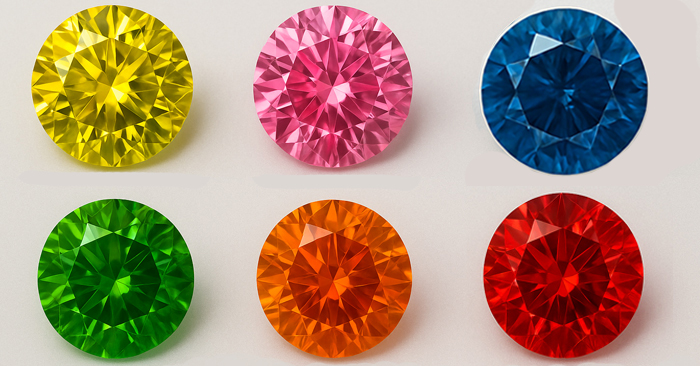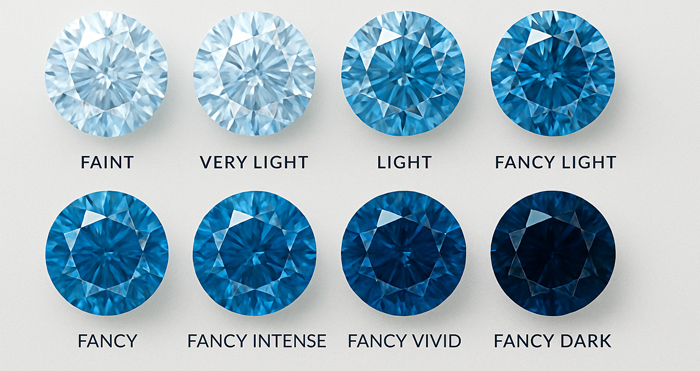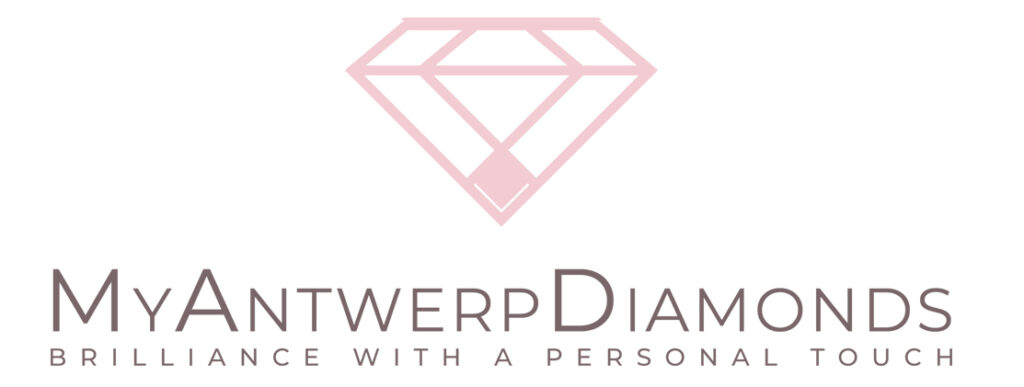Fancy Colored Diamonds at a Glance
While most diamonds are prized for their lack of color, fancy color diamonds captivate with their natural hues. These rare diamonds occur in a wide spectrum of colors—most notably yellow, pink, blue, green, and even red—each formed by unique elements and conditions deep within the earth.
Color intensity ranges from Faint to Vivid, and the stronger the color, the rarer and more valuable the stone. For example, a Vivid Pink or Fancy Intense Blue diamond can be significantly more exclusive than even the highest colorless grade.
The Colors of Fancy Diamonds
Fancy color diamonds come in an extraordinary palette, each with its own character, origin, and allure. Here are some of the most sought-after colors:
YELLOW DIAMONDS
The most popular of all fancy colors, yellow diamonds—often called canary diamonds when intensely colored—get their hue from traces of nitrogen. Vibrant and full of life, they range from soft champagne tones to vivid golden shades.
PINK DIAMONDS
Extremely rare and highly coveted, pink diamonds are associated with romance and refinement. Their exact origin of color remains a mystery, adding to their mystique. Fine pink diamonds, especially those from the Argyle mine, have become icons of beauty and value.
BLUE DIAMONDS
Colored by the presence of boron, blue diamonds evoke elegance and calm. Ranging from light sky blues to deep ocean hues, they are among the rarest of all colored diamonds and have been featured in some of history’s most legendary jewels.
GREEN DIAMONDS
Formed through natural radiation over thousands of years, green diamonds are unusual and fascinating. Their color often appears in soft, minty tones, though vivid greens do exist—and command extreme rarity.
ORANGE, VIOLET, AND RED DIAMONDS
These colors are the rarest of all. Pure orange and red diamonds are exceptionally hard to find and often exist only in small sizes. Violet diamonds, delicate and enchanting, are almost exclusively discovered in Australia and are prized for their unique charm.
BROWN AND CHAMPAGNE DIAMONDS
These diamonds offer a more earthy and understated elegance. Their warm tones can range from light mocha to rich cognac, making them a distinctive alternative to traditional white stones.

Understanding Color Intensity: How Fancy Diamonds Are Graded
The intensity grade of a fancy color diamond reflects the combined effect of its saturation and tone. Saturation measures the strength and purity of the color, while tone refers to how light or dark the color appears. Together, these two qualities determine how vivid or soft the color looks to the eye. A diamond with high saturation and a balanced tone may receive a grade like Fancy Intense or Fancy Vivid, whereas one with lower saturation or an overly light or dark tone may fall into lighter or deeper intensity categories. This combination is what defines the diamond’s overall color intensity.
Fancy color diamonds’s intensity is based on three main attributes:
Hue – the basic color (such as pink, blue, or yellow)
Tone – how light or dark the color appears
Saturation – the intensity or strength of the color
Fancy Color Intensity Scale
FAINT
A very subtle hint of color, barely noticeable. Faint color diamonds are the closest to traditional white diamonds with just a touch of tone—usually seen in yellow or brown hues.
VERY LIGHT
Still quite delicate, but with more noticeable color than Faint. These diamonds have a gentle wash of hue and are often appreciated for their softness.
LIGHT
A light but clearly visible color presence. Light fancy diamonds offer a balance between subtlety and uniqueness, often more affordable than stronger intensities.
FANCY LIGHT
Color becomes more pronounced but remains graceful and pastel-like. A popular choice for those who prefer soft yet distinguishable fancy hues.
FANCY
The mid-range intensity where color is clearly visible and well-balanced—not too pale, not too bold. This category is often a sweet spot for beauty and value.
FANCY INTENSE
Strong, rich color that stands out without being overly dark. Fancy Intense diamonds are rare and highly desirable, particularly in pink, yellow, and blue varieties.
FANCY VIVID
Exceptional saturation and brightness. Fancy Vivid is the most prized category for many colors—especially pink, blue, and yellow—offering a bold, lively appearance that commands attention and top value.
FANCY DEEP
A dark, rich tone with strong saturation. Fancy Deep diamonds often have a dramatic and sophisticated appearance, particularly in colors like blue, green, and brown.
FANCY DARK
Dark in tone and less vibrant in saturation than Fancy Deep. This category includes unique and moody diamonds that can appeal to collectors seeking something unconventional.

Comparing the Value of Fancy Color Diamonds
Fancy color diamonds are valued very differently from traditional colorless diamonds. Their worth is driven not by clarity or carat weight alone, but primarily by the color itself—specifically its hue, saturation (intensity), and rarity.
COLOR RARITY
Yellow diamonds are the most commonly available and are typically more affordable, especially in lighter intensities. However, intense and vivid yellow diamonds—often called canary diamonds—can command high prices.
Pink and blue diamonds are far rarer. Their prices increase exponentially with stronger color saturation. A Fancy Vivid Pink or Blue diamond can be many times more valuable than a white diamond of the same size.
Green, orange, and violet diamonds are extremely rare and tend to be sold at a premium, especially when their color is natural and evenly distributed.
Red diamonds are the rarest of all. Even small stones can fetch prices per carat that surpass all other diamond types.
COLOR INTENSITY
As a rule of thumb, the deeper and more vivid the color, the more valuable the diamond. For example:
A Fancy Vivid Pink may cost 5–10 times more than a Fancy Light Pink.
A Fancy Intense Blue can be rarer and more expensive than a larger colorless D-flawless diamond.
INVESTMENT AND COLLECTIBILITY
Because of their rarity and market demand, fancy color diamonds often retain or increase their value over time—especially those with strong, natural color. High-quality pink, blue, and red diamonds have seen steady appreciation and are often chosen by collectors and investors.
Top-quality D-color diamonds of the same size, with exceptional clarity and features, are the reference point
| Color | Faint / Very Light | Fancy | Fancy Vivid / Intense | Notes |
|---|---|---|---|---|
| Yellow | Affordable (~0.6× to 1×) | Moderately valued (~1×) | Premium when vivid (~2×–3×) | Most common fancy color; vivid “canary” yellow is prized |
| Pink | Rare (~1.5×–2×) | High value (~3×–5×) | Extremely valuable (~8×–10×) | Strong demand, limited supply, especially post-Argyle mine closure |
| Blue | Rare (~2×) | Very high value (~4×–6×) | Exceptional (~10×–12× or more) | Highly collectible; vivid blue stones are museum-quality rare |
| Green | Unusual (~1.5×–2×) | Rare (~3×) | High value (~6×–9×) | Natural green is rare due to limited radiation exposure during formation |
| Orange | Rare (~1.7×) | High value (~3×–4×) | Very high (~8×–10×) | Pure orange is difficult to find; often combined with brown or yellow |
| Violet | Rare (~2×) | Very rare (~4×) | Exceptional (~10×–11×) | Almost exclusively from Australia; subtle and elegant |
| Red | Extremely rare (~3×) | Incredibly rare (~6×) | Ultra-premium (~15×–20×) | The rarest of all diamonds—often under 1 carat, regardless of price |
Key Pages: Create & Customize Jewelry
Key Pages: Diamond Jewley From the Atelier
Essential Diamond & Jewelry Education
Important Links: Support & Policies
MyAntwerpDiamonds.com /
Some email responses from us may be filtered as spam or blocked altogether. To ensure you receive our emails, please provide your telephone or WhatsApp number for verification.



